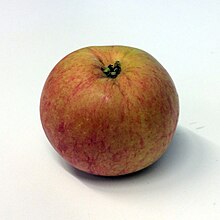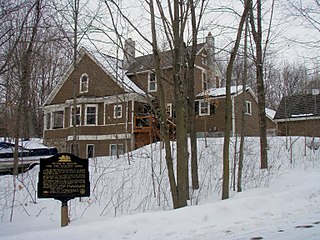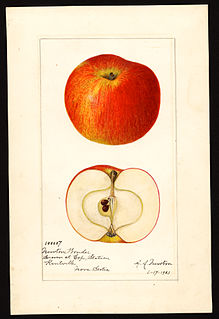
The Wealthy is an American apple cultivar, and was the earliest to thrive in the Minnesota climate. Horticulturalist Peter Gideon first grew it in 1868, after years of trial and error with various apple varieties. [1]

The Wealthy is an American apple cultivar, and was the earliest to thrive in the Minnesota climate. Horticulturalist Peter Gideon first grew it in 1868, after years of trial and error with various apple varieties. [1]
Before 1868, only crab apples grew reliably in Minnesota. Indigenous peoples in the area harvested other crops, but they did not grow apples. Early White settlers to Minnesota tried to grow apples using seeds and seedlings from their former homes to the east and the south, but their plants died, usually because of the region's harsh winters.

In 1853, Peter Gideon moved to Minnesota for health reasons and took a homestead with his family on the shores of Lake Minnetonka, near Excelsior. He had learned fruit-growing as a child, and when he arrived on his new land, he planted a bushel of apple seeds he had brought with him from his former home in Illinois. In the years that followed, Gideon experimented with apple and fruit growing, planting thousands of trees, but most of his trees died within a few years, if not right away, and none of them bore much fruit.
By 1861, Gideon and his family had only one surviving apple tree, a Siberian crab apple, and they were down to their last eight dollars. Determined to find an apple that would grow in Minnesota, Gideon sent the family's last dollars to an apple grower in Bangor, Maine, and got apple seeds and scions in return. Just one of the resulting trees, crossed with Gideon's Siberian crab apple, produced the apple that Gideon later named the Wealthy, after his wife, Wealthy (Hull) Gideon.
Until recently it was believed a Siberian crab apple was one of Wealthy's parents imparting the cultivar's cold hardiness; however, DNA testing revealed it is a cross between Duchess of Oldenburg and Jonathan. [2] [ contradictory ]
He was a member of the Minnesota State Horticultural Society, and he shared his knowledge and his trees freely, giving seedlings away to anyone who asked for them. Soon, Wealthy apples were growing in many locations in Minnesota, as well as in other states, especially states in the Upper Midwest with similar climates. In 1870, Colonel John H. Stevens addressed the Minnesota Horticultural Society with these words:
True, we were under a cloud for a long time. We planted but did not harvest. Our trees withered and perished. Whether it was the frosts of Winter or the sun of Summer that caused them to prematurely die, no one has been able to determine. Plant as we would, the trees sickened and died. No wonder, then, we became discouraged. Orchards to the third and fourth planting failed, a constant drain on the pocket without a ray of light in the future, influenced us in abandoning the enterprise. But those days, and their trials, have passed. [3]
By the early 20th century, the Wealthy apple was one of the top five apples grown nationally, but beyond his employment at the state farm, Gideon never made any money from the Wealthy apple. The Wealthy apple also was the parent of other successful Minnesota apples, such as the Haralson, which was developed at the University of Minnesota's Fruit Breeding Farm in 1922.

The McIntosh, McIntosh Red, or colloquially the Mac, is an apple cultivar, the national apple of Canada. The fruit has red and green skin, a tart flavour, and tender white flesh, which ripens in late September. In the 20th century it was the most popular cultivar in Eastern Canada and New England, and is considered an all-purpose apple, suitable both for cooking and eating raw. Apple Inc. employee Jef Raskin named the Macintosh computer line after the fruit. John McIntosh discovered the original McIntosh sapling on his Dundela farm in Upper Canada in 1811. He and his wife cultivated it, and the family started grafting the tree and selling the fruit in 1835. In 1870, it entered commercial production, and became common in northeastern North America after 1900. While still important in production, the fruit's popularity fell in the early 21st century in the face of competition from varieties such as the Gala. According to the US Apple Association website it is one of the fifteen most popular apple cultivars in the United States. A mutant(sport) of McIntosh is McIntosh Rogers, synonyms: Red Mc Intosh, Double Red Mc Intosh. This mutant was found in Dansville, New York, USA in 1930.

Fruit tree propagation is usually carried out vegetatively (non-sexually) by grafting or budding a desired variety onto a suitable rootstock.

'Golden Delicious' is a cultivar of apple. It is one of the 15 most popular cultivars in the United States. It is not closely related to 'Red Delicious'.

Malus is a genus of about 30–55 species of small deciduous trees or shrubs in the family Rosaceae, including the domesticated orchard apple – also known as the eating apple, cooking apple, or culinary apple. The other species are commonly known as crabapples, crab apples, crabtrees, wild apples, or rainberries.

Malus domestica is a cultivar of apple that is usually eaten cooked due to its sourness. The variety comes from a pip planted by Mary Ann Brailsford. The Concise Household Encyclopedia states, "Some people eat this apple raw in order to cleanse the palate, but Bramley's seedling is essentially the fruit for tart, pie, or dumpling." Once cooked, however, it has a lighter flavour. A peculiarity of the variety is that when cooked it becomes golden and fluffy. Vitamin C 15mg/100g.

Ziziphus mauritiana, also known as Indian jujube, Indian plum, Chinese date, Chinese apple, and dunks is a tropical fruit tree species belonging to the family Rhamnaceae. It is often confused with the closely related Chinese jujube, but whereas Z. jujuba prefers temperate climates, Z. mauritiana is tropical to subtropical.

Honeycrisp is an apple cultivar developed at the Minnesota Agricultural Experiment Station's Horticultural Research Center at the University of Minnesota, Twin Cities. Designated in 1974 with the MN 1711 test designation, patented in 1988, and released in 1991, the Honeycrisp, once slated to be discarded, has rapidly become a prized commercial commodity, as its sweetness, firmness, and tartness make it an ideal apple for eating raw. "...The apple wasn't bred to grow, store or ship well. It was bred for taste: crisp, with balanced sweetness and acidity." It has larger cells than most apple cultivars, a trait which is correlated with juiciness, as theoretically a higher number of cells rupture when bitten, releasing more juice in the mouth. The Honeycrisp also retains its pigment well and has a relatively long shelf life when stored in cool, dry conditions. Pepin Heights Orchards delivered the first Honeycrisp apples to grocery stores in 1997. The name Honeycrisp was trademarked by the University of Minnesota, but university officials were unsure of its protection status in 2007. It is now the official state fruit of Minnesota. A large-sized honeycrisp will contain about 113 calories.

Thomas Andrew Knight (1759–1838), FRS, of Elton Hall in the parish of Elton in Herefordshire and later of Downton Castle, was a British horticulturalist and botanist. He served as the 2nd President of the Royal Horticultural Society (1811–1838).

Peter Gideon (1820–1899) was a farmer near Excelsior, Minnesota, United States, who was responsible for breeding apples that could withstand Minnesota's climate. Gideon's farmhouse, now within the boundaries of Shorewood, Minnesota, is listed on the National Register of Historic Places.

An apple is an edible fruit produced by an apple tree. Apple trees are cultivated worldwide and are the most widely grown species in the genus Malus. The tree originated in Central Asia, where its wild ancestor, Malus sieversii, is still found today. Apples have been grown for thousands of years in Asia and Europe and were brought to North America by European colonists. Apples have religious and mythological significance in many cultures, including Norse, Greek, and European Christian tradition.

The Zestar! apple or Minnewashta (cultivar) is an apple cultivar released in 1999. It was developed by the horticulturalists at the Minnesota Landscape Arboretum's Horticultural Resource Center, at the University of Minnesota.

The 'York Imperial', or 'York', is a cultivar of apple from which a number of other valuable strains and cultivars have arisen, including four sport varieties: Commander York, Ramey York, Red Yorking, and Yorking.

Malus domestica Newton Wonder is a cultivar of apple which is usually eaten cooked due to its sourness. The variety has a similar but slightly sweeter taste than the Bramley apple and is usually used in pies or as a preserve.
The Minnesota State Horticultural Society (MSHS), with headquarters in Roseville, Minnesota, is a nonprofit membership organization that provides education and resources to northern gardeners in the United States. It publishes Northern Gardener, a bi-monthly magazine that is the only U.S. publication devoted exclusively to gardening in Hardiness Zones 3-5. Its "Garden-in-a-Box" program provides raised bed garden boxes, along with soil and vegetable plants, to low-income families and schoolchildren in the greater Minneapolis and St. Paul, Minnesota area and elsewhere in Minnesota. "Minnesota Green" is a MSHS program that coordinates donations of plant material from growers, garden centers, and individuals to public space and community gardens. MSHS offers classes year-round on gardening subjects. MSHS currently has 10,000 members and subscribers to its publication.

Dumelow's Seedling is a cultivar of domesticated apple that originated at Shackerstone in Leicestershire where it was grown by Richard Dumeller in 1800. It is known by many other names including 'Dumelow's Crab', 'Wellington', 'Doncklaer', 'Beauty', and 'Belle de Vennes'. The fruit is not ready for harvest until October, being one of the last of the season, and keeps well into the next year. Though inferior for use as a dessert apple it cooks well and in early-20th century England was one of the most valuable varieties of cooking apple.
Isabella Preston was a horticulturist and public servant widely recognized for her achievements in plant hybridization and extensive work in ornamental plant breeding. During her 26-year career, she produced nearly 200 new hardy hybrids of lily, lilac, crab apple, iris and rose plants for Canada's cold climate. While female plant breeders were rather rare in her day, she quietly challenged gender bias and set the stage for new generations of breeding programs at the Central Experimental Farm in Ottawa, Ontario, Canada and elsewhere.
John Samuel Harris was an early American horticulturist, the first person to successfully plant and propagate apple trees in Minnesota, a climate in which it was previously thought that the fruit could not survive the harsh northern U.S winters.

The MN55 cultivar apple developed by David Bedford, a senior researcher and research pomologist at the University of Minnesota's apple-breeding program, and James Luby, PhD, professor, Department of Horticultural Sciences, Horticultural Research Center, is a cross between Honeycrisp and MonArk (AA44), a non-patented apple variety grown in Arkansas.

EverCrisp is an American apple cultivar developed by the Midwest Apple Improvement Association (MAIA). Trademarked as EverCrisp, the MAIA-1 variety is a cross between two existing apple cultivars – the Honeycrisp and Fuji. Originally produced in Ohio, EverCrisp has since expanded to apple-growing regions across the Midwest in Michigan, Illinois and Indiana, and in the Northeast in Pennsylvania and New York. The apple entered the public marketplace in 2017.

The Wagener is a cultivar of the domesticated apple. It was first farmed in 1791 in New York, and is the parent of the Idared and, possibly, the Northern Spy. Despite the early popularity of the Wagener, it is no longer widely grown.